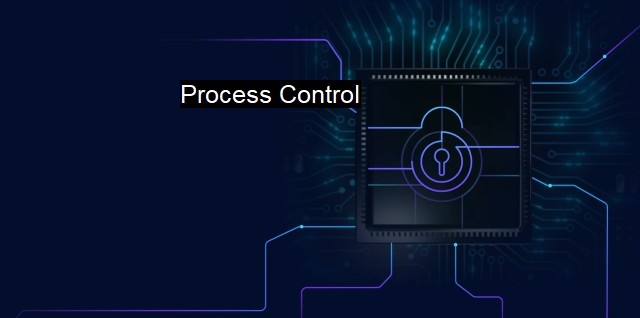What is Process Control?
Effective Process Control: The Key to Ensuring Cybersecurity in Today's Evolving Threat Landscape
Process control is a vital concept in many industries, including the cybersecurity sector. In simple terms, process control refers to the ability to maintain optimal performance and quality of a specific system or process.process control is crucial in ensuring that all security systems and tools are operating correctly and effectively. Cybersecurity threats are continually evolving, and cybercriminals are becoming more sophisticated in their approach. Therefore, having a solid process control strategy is essential for any organization that wants to protect itself from cyber threats successfully.
One of the key aspects of process control in cybersecurity is automation. With automation, organizations can optimize their security protocols and reduce the risks of human error. This is particularly critical in the context of antivirus software, which relies heavily on automated detection and mitigation processes to identify and remediate threats.
automation does not eliminate the need for human oversight altogether. Even with the most advanced software and tools, cybersecurity professionals must still monitor and analyze the data generated by security systems to ensure that they are functioning correctly. when new threats are identified, security personnel must take immediate action to prevent or mitigate the potential harm.
Another essential aspect of process control in cybersecurity is continuous monitoring. Cybersecurity threats can emerge at any time, and therefore, organizations must implement systems that actively and consistently monitor their networks and systems. This allows them to spot potential incidents early, analyze the behavior of suspicious activities and take rapid, preventative measures.
Some of the critical features of a process control strategy in antivirus and cybersecurity include the following:
1. Centralized management
A strong process control strategy should encompass centralized management of cybersecurity tools and systems. This includes the ability to update, configure, and initiate security processes across an organization's entire network and systems.
2. Rapid response times
To effectively mitigate security threats, cybersecurity teams need to respond rapidly to potential incidents. A streamlined, efficient process for the identification, reporting, and handling of security events is essential.
3. Data analysis and automation
Automation and data analysis are critical components of a modern cybersecurity process control strategy. By leveraging machine learning algorithms and other automated technologies, organizations can analyze vast quantities of data to identify potential threats proactively.
4. Robust training systems
A successful process control strategy in cybersecurity must also incorporate comprehensive training programs. Effective training ensures that all personnel working with security systems and data have a thorough understanding of security processes, the threats involved, and protocols for handling potential incidents.
a comprehensive process control strategy is a critical component of any organization's cybersecurity protocols. By implementing automation, continuous monitoring, centralized management, data analysis, and robust training programs, organizations can reduce their vulnerability to cyber threats and protect themselves from potentially devastating attacks.

Process Control FAQs
What is process control in cybersecurity and antivirus?
Process control refers to the management and regulation of various processes and functions within a system or network. In cybersecurity and antivirus, process control involves monitoring and managing the various software components, applications, and tasks running on a system or network to ensure optimal performance and security. This includes identifying and regulating any suspicious or unauthorized processes and preventing them from compromising the system or network.How does process control help in preventing cyber attacks and virus infections?
Process control plays a critical role in preventing cyber attacks and virus infections by ensuring that only authorized processes and applications are allowed to run on the system or network. By monitoring and regulating the flow of data and processes within the system, process control can identify and prevent any malicious or suspicious activity, and prevent it from compromising the system. This helps to minimize the risk of cyber attacks and virus infections and improve overall security.What are some common process control tools used in cybersecurity and antivirus?
Some common process control tools used in cybersecurity and antivirus include firewalls, intrusion detection/prevention systems, antivirus software, and security information and event management (SIEM) systems. These tools help to monitor and regulate the various processes and applications within a system, detect any suspicious or unauthorized activity, and prevent any potential security breaches.How can organizations implement effective process control measures in their cybersecurity and antivirus strategy?
To implement an effective process control strategy, organizations should first identify the critical processes and applications that are essential for their business operations. They should then implement appropriate controls and monitoring mechanisms to manage and regulate these processes, and ensure that only authorized users and applications are allowed access. Regular audits and assessments should also be conducted to identify any potential vulnerabilities or gaps in the process control measures and address them promptly. Finally, organizations should ensure that their process control strategy is regularly reviewed and updated to stay in line with emerging threats and evolving business requirements.| | A | | | B | | | C | | | D | | | E | | | F | | | G | | | H | | | I | | | J | | | K | | | L | | | M | |
| | N | | | O | | | P | | | Q | | | R | | | S | | | T | | | U | | | V | | | W | | | X | | | Y | | | Z | |
| | 1 | | | 2 | | | 3 | | | 4 | | | 7 | | | 8 | | |||||||